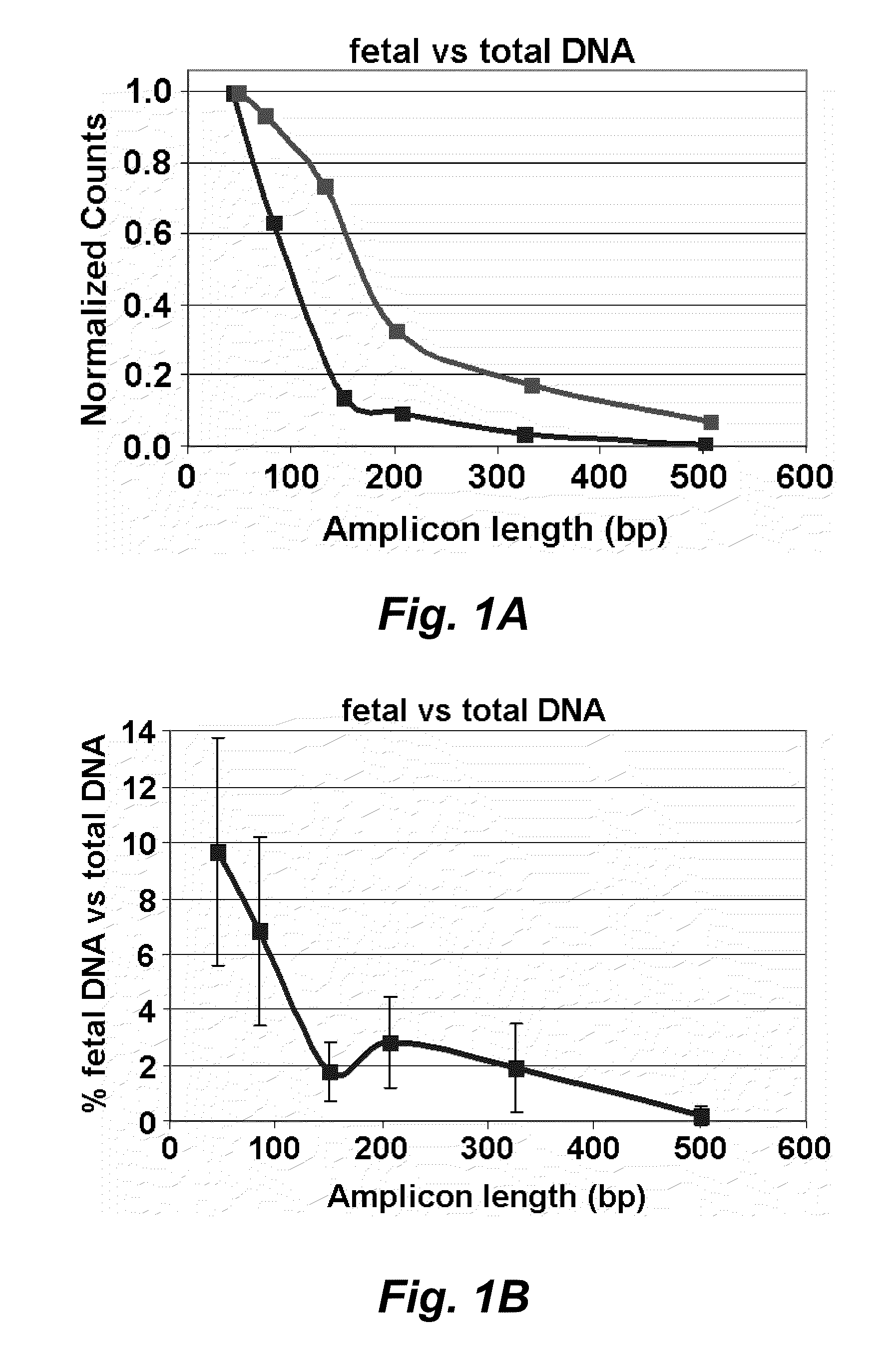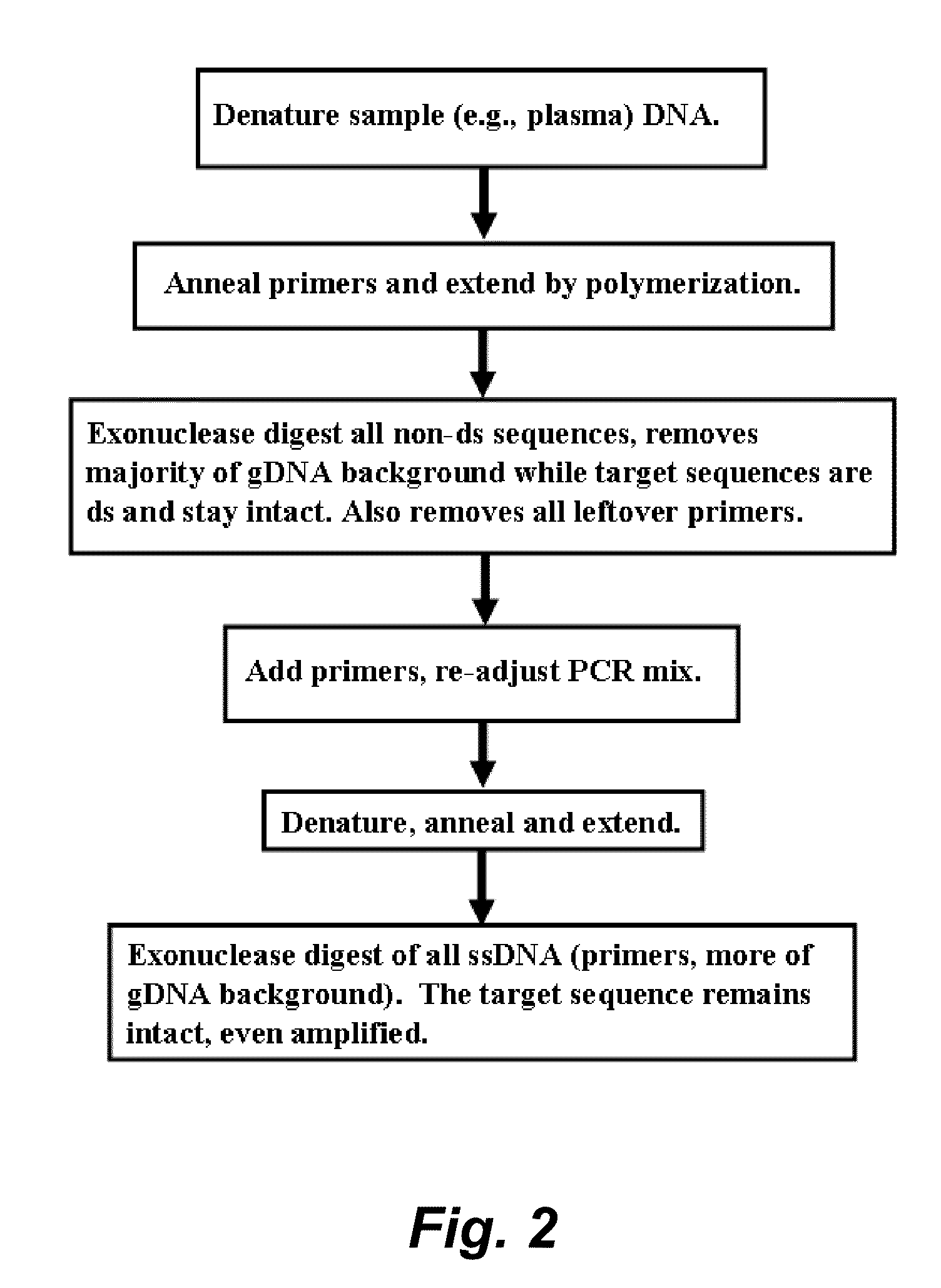Selective tagging of short nucleic acid fragments and selective protection of target sequences from degradation
a technology of short nucleic acid fragments and selective tagging, which is applied in the direction of biochemical equipment and processes, biochemical water/sewage treatment, chemistry equipment and processes, etc., can solve the problems of unsatisfactory and clinically acceptable methods that have not yet emerged
- Summary
- Abstract
- Description
- Claims
- Application Information
AI Technical Summary
Benefits of technology
Problems solved by technology
Method used
Image
Examples
example 1
Proof of Principle 1.2
Targets:
[0173]The following targets were prepared: 1) Fragmented plasmid (3000 and 500 copies) win which plasmid DNA was restriction digested to yield independent fragments of either inner tagged primer pair (“target”) or one of outer primers; 2 Linear plasmid comprising a long fragment produced by linearlizing a plasmid with outer primers on same fragment as inner tagged primers, within 50 by (d=100); 3) gDNA comprising Long: outer primers on same fragment as inner tagged primers, within 100 by (d=150); and NTC.
Protocol: Tagging of the Short:
[0174]Two cycles of tagging were performed with:
[0175]inner tagged primers only: Positive Control;
[0176]outer primer pair (900 nM) only: Negative control;
[0177]inner tagged primers (300 nM) and outer preimers (900 nM): Suppression;
[0178]inner tagged primers (100 nM) and outer primers (900 nM): Suppression; and
[0179]without assays: Negative control.
[0180]The mixture was treated with ExoSAP-it treatment to remove primers. Th...
example 2
Proof of Principle 1.3
[0185]A similar experiment was performed with the inner primer at 300 nM or 100 mM and the outer primer at 900 nM. This example provides an exemplary protocol for carrying out an assay method of the invention to genotype 16 SNPs in 144 samples using a 48.48 Dynamic Array available from Fluidigm Corporation, South San Francisco, Calif.
[0186]As shown in the graph (FIG. 9) and the heat map (FIG. 10) the fragmented plasmid showed no or minimal effect of the presence of the outer primers. Long DNA detection was suppressed almost completely by presence of outer primers (linear plasmid, gDNA). This worked at all concentrations. All controls were negative as expected.
example 3
Proof of Principle 1.4
Extra Cycles
[0187]The goal was to amplify tagged (short) product from two cycles in the same mix for another number of cycles. The annealing temperature (TA) was raised to prevent tagged primers from binding any sequence without tag.
[0188]The method was expected to increase the number of spots and thereby enable other applications such as FACts, hd-DID, and the like. The method was also expected to reduce background.
[0189]After two cycles of tagging (e.g., as above), the TA was increased to 72° C. from 60° C. At this temperature, only tagged primers will anneal, and only tagged product from first 2 cycles will amplify. Nine PCR cycles were performed at 95° C.-72°. The mixture was then treated with ExoSAP-IT, diluted, and analyzed in a digital chip.
[0190]The results are shown in Table 3.
TABLE 3Results of extra amplification cycles.amplification(compared toInnerOuter and InnersuppressionPOC1.4)fragmented21762211−2%430plasmidlinear14528094%538plasmidgenomic DNA237...
PUM
| Property | Measurement | Unit |
|---|---|---|
| concentration | aaaaa | aaaaa |
| concentration | aaaaa | aaaaa |
| Tm | aaaaa | aaaaa |
Abstract
Description
Claims
Application Information
 Login to View More
Login to View More - R&D
- Intellectual Property
- Life Sciences
- Materials
- Tech Scout
- Unparalleled Data Quality
- Higher Quality Content
- 60% Fewer Hallucinations
Browse by: Latest US Patents, China's latest patents, Technical Efficacy Thesaurus, Application Domain, Technology Topic, Popular Technical Reports.
© 2025 PatSnap. All rights reserved.Legal|Privacy policy|Modern Slavery Act Transparency Statement|Sitemap|About US| Contact US: help@patsnap.com



